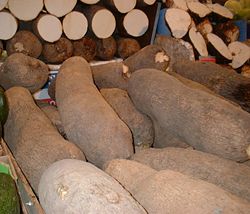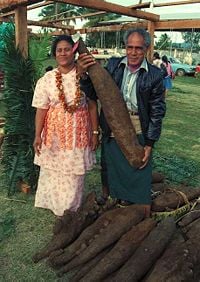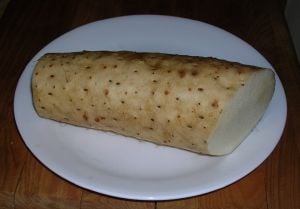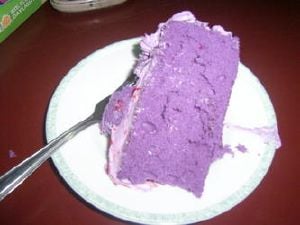Difference between revisions of "Yam" - New World Encyclopedia
| Line 20: | Line 20: | ||
==Cultivation== | ==Cultivation== | ||
| + | [[Image:Kiekie yams.jpg|thumb|200px|left|Tongan farmer showing off his prize yams]] | ||
The tubers of most species of yam are poisonous to humans. A few are edible and some others can be made edible by various methods including soaking, boiling, and drying. People started to cultivate yams, rather than just digging up wild ones, as long as 10,000 years ago in both Africa and Asia; and some time later in the New World. | The tubers of most species of yam are poisonous to humans. A few are edible and some others can be made edible by various methods including soaking, boiling, and drying. People started to cultivate yams, rather than just digging up wild ones, as long as 10,000 years ago in both Africa and Asia; and some time later in the New World. | ||
| − | The cultivation of yams is very labor intensive. Cultivated yams mostly do not produce seeds and so tubers or pieces of tuber must be planted in prepared soil, most often in mounds, to grow new plants. Some kind of framework or trellis must be provided to support the vines, unless they are grown next to trees or in fields previously planted with corn so the old stalks can provide support. At the | + | The cultivation of yams is very labor intensive. Cultivated yams mostly do not produce seeds and so tubers or pieces of tuber must be planted in prepared soil, most often in mounds, to grow new plants. Some kind of framework or trellis must be provided to support the vines, unless they are grown next to trees or in fields previously planted with corn so the old stalks can provide support. At the beginning of the dry season the vines die away and the tubers are ready to be harvested. They must be dug out by hand very carefully; if they are damaged they could spoil soon (Kay 1987). |
| − | Yams are a | + | Yams are a nutritious food providing [[carbohydrates]], some [[protein]], and minerals like [[phosphorus]] and [[potassium]]. Tubers can be stored as long a six months without refrigeration (CGAIR 2006). |
| − | + | For hundreds of years yams were the most important food in many parts of Africa and the Pacific islands. There are many traditions associated with yams including ceremonies and festivals which show their importance in traditional society. | |
| − | |||
| − | |||
| − | + | Today West Africa produces over 90 percent of the world's yam crop, with [[Nigeria]] the largest grower. [[South America]], the [[West Indies]], the Pacific islands, and some parts of [[Asia]] also grow some yams. Most are grown for local consumption. There is also a small international trade and some are grown for medicinal and other uses (CGAIR 2006). | |
| − | == | + | ==Cultivated yam species== |
| − | |||
| − | |||
| − | |||
| − | |||
| − | |||
| − | |||
| − | |||
| − | |||
| − | |||
| − | |||
| − | |||
| − | |||
| − | |||
| − | |||
| − | |||
| − | |||
| − | |||
| − | |||
| − | |||
| − | |||
| − | |||
| − | |||
| − | |||
| − | + | ===Dioscorea rotundata and D. cayenensis=== | |
| − | + | ===D. bulbifera=== | |
| − | |||
| − | |||
| − | |||
| − | |||
| − | == | ||
| − | |||
| − | |||
| − | |||
| − | |||
| − | |||
| − | |||
| − | |||
| − | |||
| − | |||
| − | |||
| − | |||
| − | |||
| − | |||
| − | |||
| − | |||
| − | |||
| − | = | ||
| − | |||
| − | |||
[[Image:Dioscorea bulbifera.jpg|thumb|Air potato]] | [[Image:Dioscorea bulbifera.jpg|thumb|Air potato]] | ||
'''''Dioscorea bulbifera''''' is a species of [[Yam (vegetable)|yam]] known as the '''air potato'''. It is a perennial vine with broad leaves and two types of [[storage organ]]s. The plant forms [[bulb]]ils in the leaf axils of the twining stems, and [[tuber]]s beneath the ground. These tubers are like small, oblong [[potato]]es, and they are edible and cultivated as a food crop, especially in [[West Africa]]. The tubers often have a bitter taste, which can be removed by boiling. They can then be prepared in the same way as other yams, potatoes, and [[sweet potato]]es. The air potato is one of the most widely-consumed yam species. | '''''Dioscorea bulbifera''''' is a species of [[Yam (vegetable)|yam]] known as the '''air potato'''. It is a perennial vine with broad leaves and two types of [[storage organ]]s. The plant forms [[bulb]]ils in the leaf axils of the twining stems, and [[tuber]]s beneath the ground. These tubers are like small, oblong [[potato]]es, and they are edible and cultivated as a food crop, especially in [[West Africa]]. The tubers often have a bitter taste, which can be removed by boiling. They can then be prepared in the same way as other yams, potatoes, and [[sweet potato]]es. The air potato is one of the most widely-consumed yam species. | ||
| Line 91: | Line 43: | ||
The air potato plant is native to [[Africa]] and [[Asia]]. In other areas of the globe, notably [[Florida]], it is an [[invasive species]]. It is a quick-growing, large-leafed vine which spreads tenaciously and shades out any plants growing beneath it. The bulbils on the vines sprout and become new vines, twisting around each other to form a thick mat. If the plant is cut to the ground, the tubers can survive for extended periods and send up new shoots later. | The air potato plant is native to [[Africa]] and [[Asia]]. In other areas of the globe, notably [[Florida]], it is an [[invasive species]]. It is a quick-growing, large-leafed vine which spreads tenaciously and shades out any plants growing beneath it. The bulbils on the vines sprout and become new vines, twisting around each other to form a thick mat. If the plant is cut to the ground, the tubers can survive for extended periods and send up new shoots later. | ||
| − | == | + | ===D. opposita=== |
[[Image:Dioscorea opposita (batatas).jpg|thumb|Segment of a ''Dioscorea opposita'' tuber]] | [[Image:Dioscorea opposita (batatas).jpg|thumb|Segment of a ''Dioscorea opposita'' tuber]] | ||
| Line 104: | Line 56: | ||
The tuber is also used (often in dried form) in [[traditional Chinese medicine]] and [[Chinese herbology]]. | The tuber is also used (often in dried form) in [[traditional Chinese medicine]] and [[Chinese herbology]]. | ||
| − | == | + | ===D. alata=== |
[[Image:Ube_Cake.jpg|thumb|right|A Piece of Cake Made With Ube.]] | [[Image:Ube_Cake.jpg|thumb|right|A Piece of Cake Made With Ube.]] | ||
| Line 115: | Line 67: | ||
Ube is now used in a variety of desserts, as well as a flavour for [[ice cream]], [[Swiss roll]]s, tarts, cookies, cakes, and pastries. | Ube is now used in a variety of desserts, as well as a flavour for [[ice cream]], [[Swiss roll]]s, tarts, cookies, cakes, and pastries. | ||
| − | == | + | ===D. esculenta=== |
| − | == | + | ===D. trifida=== |
| − | == | + | ===D. dumetorum=== |
| − | == | + | ===D. hispida=== |
| − | + | ||
==References== | ==References== | ||
Revision as of 20:56, 20 August 2006
| Dioscorea (Yam) | ||||||||||||
|---|---|---|---|---|---|---|---|---|---|---|---|---|
 | ||||||||||||
| Scientific classification | ||||||||||||
|
Yams are members of the flowering plant genus Dioscorea. They are monocots, related to palms, grasses, and orchids. There are about 600 species of yams found around the world, mostly in the tropics. Some species of yam are cultivated for their edible tubers, for medicinal use, and for other uses. Yams remain an important food crop, especially in Africa.
In the United States sweet potatoes, Ipomoea batatas, are sometimes called "yams", although they are not closely related.
The yam plant
Most yam species grow in the tropics and sub-tropics in areas with fairly heavy total annual rainfall but with a definate dry season. During the rainy season they produce one or more underground tubers to store food and water through the dry season. The tubers are thickened stems. At the end of the dry season they send out shoots which grow into vines which grow up into nearby trees and bushes. Many species grow bulbils, small tuber like growths, at the bases of their leaves. These can fall to the ground and produce new plants. Most yam plants have small flowers with one plant having only male or female flowers (Kay, 1987).
Cultivation
The tubers of most species of yam are poisonous to humans. A few are edible and some others can be made edible by various methods including soaking, boiling, and drying. People started to cultivate yams, rather than just digging up wild ones, as long as 10,000 years ago in both Africa and Asia; and some time later in the New World.
The cultivation of yams is very labor intensive. Cultivated yams mostly do not produce seeds and so tubers or pieces of tuber must be planted in prepared soil, most often in mounds, to grow new plants. Some kind of framework or trellis must be provided to support the vines, unless they are grown next to trees or in fields previously planted with corn so the old stalks can provide support. At the beginning of the dry season the vines die away and the tubers are ready to be harvested. They must be dug out by hand very carefully; if they are damaged they could spoil soon (Kay 1987).
Yams are a nutritious food providing carbohydrates, some protein, and minerals like phosphorus and potassium. Tubers can be stored as long a six months without refrigeration (CGAIR 2006).
For hundreds of years yams were the most important food in many parts of Africa and the Pacific islands. There are many traditions associated with yams including ceremonies and festivals which show their importance in traditional society.
Today West Africa produces over 90 percent of the world's yam crop, with Nigeria the largest grower. South America, the West Indies, the Pacific islands, and some parts of Asia also grow some yams. Most are grown for local consumption. There is also a small international trade and some are grown for medicinal and other uses (CGAIR 2006).
Cultivated yam species
Dioscorea rotundata and D. cayenensis
D. bulbifera
Dioscorea bulbifera is a species of yam known as the air potato. It is a perennial vine with broad leaves and two types of storage organs. The plant forms bulbils in the leaf axils of the twining stems, and tubers beneath the ground. These tubers are like small, oblong potatoes, and they are edible and cultivated as a food crop, especially in West Africa. The tubers often have a bitter taste, which can be removed by boiling. They can then be prepared in the same way as other yams, potatoes, and sweet potatoes. The air potato is one of the most widely-consumed yam species.
The air potato plant is native to Africa and Asia. In other areas of the globe, notably Florida, it is an invasive species. It is a quick-growing, large-leafed vine which spreads tenaciously and shades out any plants growing beneath it. The bulbils on the vines sprout and become new vines, twisting around each other to form a thick mat. If the plant is cut to the ground, the tubers can survive for extended periods and send up new shoots later.
D. opposita
Dioscorea opposita (also Dioscorea batatas, Dioscorea japonica, Dioscorea polystachya, Dioscorea oppositifolia, nagaimo, yamaimo, Chinese yam, Japanese mountain yam, Korean yam) is a type of yam (Dioscoreaceae) that may be eaten raw.
It is known as either nagaimo (kanji: 長芋; hiragana: ながいも) or yamaimo (kanji: 山芋; hiragana: やまいも) in Japanese, depending on root shape. In Chinese it is known as huái shān (淮山), shān yào (山药), or huái shān yào (淮山药).
Dioscorea opposita is an exception to the rule that yams must be cooked before consumption (due to harmful substances in the raw state). In Japanese cuisine, it is eaten raw and grated, after only a relatively minimal preparation: the whole tubers are briefly soaked in a vinegar-water solution, to neutralize irritant oxalate crystals found in their skin. The raw vegetable is starchy and bland, mucilaginous when grated, and may be eaten plain as a side dish, or added to noodles.
Dioscorea opposita is used in the Japanese cold noodle dish tororo udon. The grated nagaimo is known as tororo (in Japanese). In tororo udon, the tororo is mixed with other ingredients that typically include tsuyu broth (dashi), wasabi, and green onions. Jinenjo (wild yam) is another variety of Japanese yam that is used as an ingredient in soba noodles.
The tuber is also used (often in dried form) in traditional Chinese medicine and Chinese herbology.
D. alata
Ube (or ubi) is the Tagalog word for purple yam (Dioscorea alata). In India, this vegetable is known as ratalu or violet yam or the Moraga Surprise. In the Philippines, ube is eaten as a sweetened dessert called halaya. Ube is also an ingredient in the fruity dessert halo halo, another popular Filipino dessert.
In botany, this species is also known by the names "water yam" and "winged yam".
Probably brought to the Philippines by settlers, the ube plant spread like a weed unknown to locals. It was discovered around the time of famine when people were desperate for food.
Ube is now used in a variety of desserts, as well as a flavour for ice cream, Swiss rolls, tarts, cookies, cakes, and pastries.
D. esculenta
D. trifida
D. dumetorum
D. hispida
ReferencesISBN links support NWE through referral fees
- Consultative Group on International Agricultural Research (CGIAR), 1994, "A Breakthrough in Yam Breeding"[1]
- Consultative Group on International Agricultural Research (CGIAR), 2006, "Yam"[2]
- Kay, D.E., 1987, Root Crops, Tropical Development and Research Institute : London[3]
- O'Hair, S.K., 1990, "Tropical Root and Tuber Crops", p. 424-428. In: J. Janick and J.E. Simon (eds.), Advances in New Crops. Timber Press : Portland, OR.[4]
- Schultz, G.E., 1993, "Element Stewardship Abstract for Dioscorea bulbifera, Air potato", The Nature Conservancy[5]
- University of Connecticut(UC), 2006, "Dioscoreaceae"[6]
- White, L.D., 2003, Canoe Plants of Ancient Hawai'i, "Uhi"[7]
Credits
New World Encyclopedia writers and editors rewrote and completed the Wikipedia article in accordance with New World Encyclopedia standards. This article abides by terms of the Creative Commons CC-by-sa 3.0 License (CC-by-sa), which may be used and disseminated with proper attribution. Credit is due under the terms of this license that can reference both the New World Encyclopedia contributors and the selfless volunteer contributors of the Wikimedia Foundation. To cite this article click here for a list of acceptable citing formats.The history of earlier contributions by wikipedians is accessible to researchers here:
The history of this article since it was imported to New World Encyclopedia:
Note: Some restrictions may apply to use of individual images which are separately licensed.


